Nam Sung Kim
Transforming the Hybrid Cloud for Emerging AI Workloads
Nov 20, 2024Abstract:This white paper, developed through close collaboration between IBM Research and UIUC researchers within the IIDAI Institute, envisions transforming hybrid cloud systems to meet the growing complexity of AI workloads through innovative, full-stack co-design approaches, emphasizing usability, manageability, affordability, adaptability, efficiency, and scalability. By integrating cutting-edge technologies such as generative and agentic AI, cross-layer automation and optimization, unified control plane, and composable and adaptive system architecture, the proposed framework addresses critical challenges in energy efficiency, performance, and cost-effectiveness. Incorporating quantum computing as it matures will enable quantum-accelerated simulations for materials science, climate modeling, and other high-impact domains. Collaborative efforts between academia and industry are central to this vision, driving advancements in foundation models for material design and climate solutions, scalable multimodal data processing, and enhanced physics-based AI emulators for applications like weather forecasting and carbon sequestration. Research priorities include advancing AI agentic systems, LLM as an Abstraction (LLMaaA), AI model optimization and unified abstractions across heterogeneous infrastructure, end-to-end edge-cloud transformation, efficient programming model, middleware and platform, secure infrastructure, application-adaptive cloud systems, and new quantum-classical collaborative workflows. These ideas and solutions encompass both theoretical and practical research questions, requiring coordinated input and support from the research community. This joint initiative aims to establish hybrid clouds as secure, efficient, and sustainable platforms, fostering breakthroughs in AI-driven applications and scientific discovery across academia, industry, and society.
Defensive ML: Defending Architectural Side-channels with Adversarial Obfuscation
Feb 03, 2023Abstract:Side-channel attacks that use machine learning (ML) for signal analysis have become prominent threats to computer security, as ML models easily find patterns in signals. To address this problem, this paper explores using Adversarial Machine Learning (AML) methods as a defense at the computer architecture layer to obfuscate side channels. We call this approach Defensive ML, and the generator to obfuscate signals, defender. Defensive ML is a workflow to design, implement, train, and deploy defenders for different environments. First, we design a defender architecture given the physical characteristics and hardware constraints of the side-channel. Next, we use our DefenderGAN structure to train the defender. Finally, we apply defensive ML to thwart two side-channel attacks: one based on memory contention and the other on application power. The former uses a hardware defender with ns-level response time that attains a high level of security with half the performance impact of a traditional scheme; the latter uses a software defender with ms-level response time that provides better security than a traditional scheme with only 70% of its power overhead.
BNS-GCN: Efficient Full-Graph Training of Graph Convolutional Networks with Partition-Parallelism and Random Boundary Node Sampling
Mar 26, 2022



Abstract:Graph Convolutional Networks (GCNs) have emerged as the state-of-the-art method for graph-based learning tasks. However, training GCNs at scale is still challenging, hindering both the exploration of more sophisticated GCN architectures and their applications to real-world large graphs. While it might be natural to consider graph partition and distributed training for tackling this challenge, this direction has only been slightly scratched the surface in the previous works due to the limitations of existing designs. In this work, we first analyze why distributed GCN training is ineffective and identify the underlying cause to be the excessive number of boundary nodes of each partitioned subgraph, which easily explodes the memory and communication costs for GCN training. Furthermore, we propose a simple yet effective method dubbed BNS-GCN that adopts random Boundary-Node-Sampling to enable efficient and scalable distributed GCN training. Experiments and ablation studies consistently validate the effectiveness of BNS-GCN, e.g., boosting the throughput by up to 16.2x and reducing the memory usage by up to 58%, while maintaining a full-graph accuracy. Furthermore, both theoretical and empirical analysis show that BNS-GCN enjoys a better convergence than existing sampling-based methods. We believe that our BNS-GCN has opened up a new paradigm for enabling GCN training at scale. The code is available at https://github.com/RICE-EIC/BNS-GCN.
PipeGCN: Efficient Full-Graph Training of Graph Convolutional Networks with Pipelined Feature Communication
Mar 20, 2022



Abstract:Graph Convolutional Networks (GCNs) is the state-of-the-art method for learning graph-structured data, and training large-scale GCNs requires distributed training across multiple accelerators such that each accelerator is able to hold a partitioned subgraph. However, distributed GCN training incurs prohibitive overhead of communicating node features and feature gradients among partitions for every GCN layer during each training iteration, limiting the achievable training efficiency and model scalability. To this end, we propose PipeGCN, a simple yet effective scheme that hides the communication overhead by pipelining inter-partition communication with intra-partition computation. It is non-trivial to pipeline for efficient GCN training, as communicated node features/gradients will become stale and thus can harm the convergence, negating the pipeline benefit. Notably, little is known regarding the convergence rate of GCN training with both stale features and stale feature gradients. This work not only provides a theoretical convergence analysis but also finds the convergence rate of PipeGCN to be close to that of the vanilla distributed GCN training without any staleness. Furthermore, we develop a smoothing method to further improve PipeGCN's convergence. Extensive experiments show that PipeGCN can largely boost the training throughput (1.7x~28.5x) while achieving the same accuracy as its vanilla counterpart and existing full-graph training methods. The code is available at https://github.com/RICE-EIC/PipeGCN.
Harmony: Overcoming the hurdles of GPU memory capacity to train massive DNN models on commodity servers
Feb 02, 2022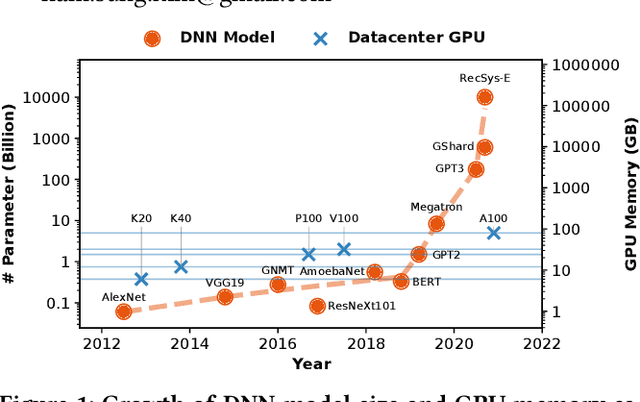
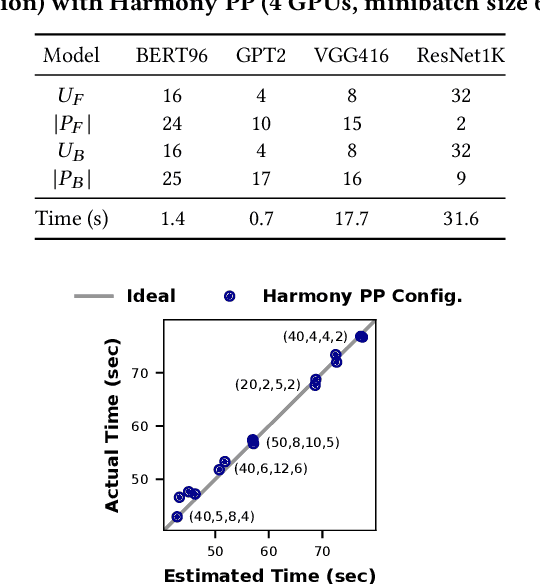

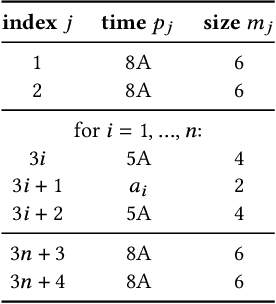
Abstract:Deep neural networks (DNNs) have grown exponentially in complexity and size over the past decade, leaving only those who have access to massive datacenter-based resources with the ability to develop and train such models. One of the main challenges for the long tail of researchers who might have access to only limited resources (e.g., a single multi-GPU server) is limited GPU memory capacity compared to model size. The problem is so acute that the memory requirement of training large DNN models can often exceed the aggregate capacity of all available GPUs on commodity servers; this problem only gets worse with the trend of ever-growing model sizes. Current solutions that rely on virtualizing GPU memory (by swapping to/from CPU memory) incur excessive swapping overhead. In this paper, we present a new training framework, Harmony, and advocate rethinking how DNN frameworks schedule computation and move data to push the boundaries of training large models efficiently on modest multi-GPU deployments. Across many large DNN models, Harmony is able to reduce swap load by up to two orders of magnitude and obtain a training throughput speedup of up to 7.6x over highly optimized baselines with virtualized memory.
Bit-Parallel Vector Composability for Neural Acceleration
Apr 11, 2020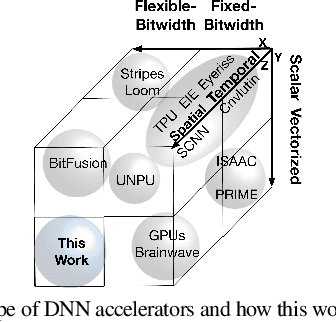
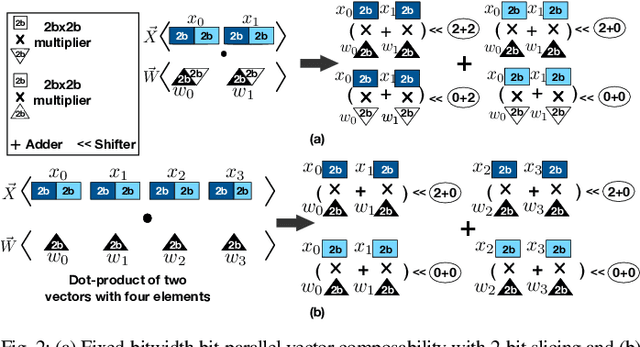
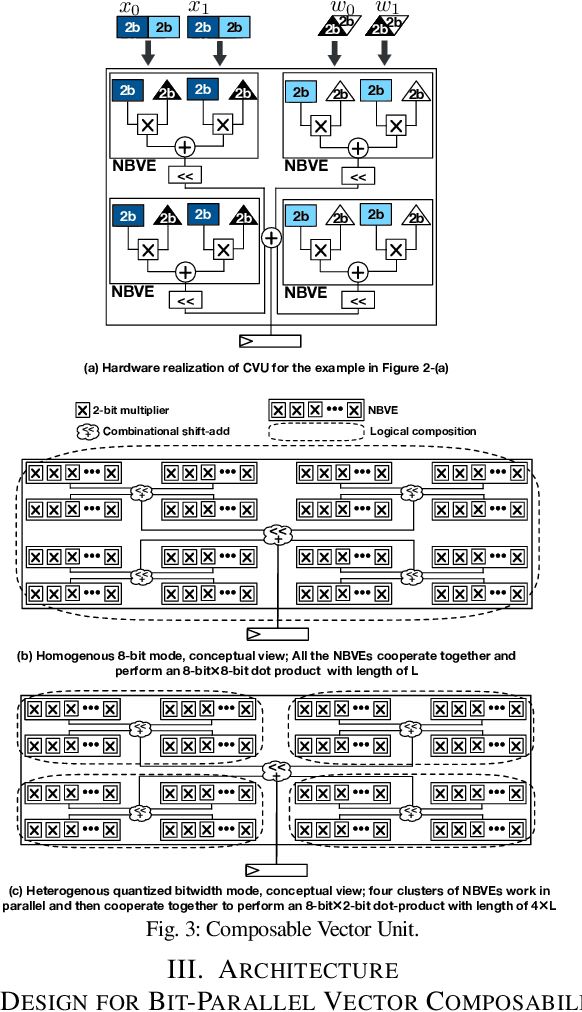

Abstract:Conventional neural accelerators rely on isolated self-sufficient functional units that perform an atomic operation while communicating the results through an operand delivery-aggregation logic. Each single unit processes all the bits of their operands atomically and produce all the bits of the results in isolation. This paper explores a different design style, where each unit is only responsible for a slice of the bit-level operations to interleave and combine the benefits of bit-level parallelism with the abundant data-level parallelism in deep neural networks. A dynamic collection of these units cooperate at runtime to generate bits of the results, collectively. Such cooperation requires extracting new grouping between the bits, which is only possible if the operands and operations are vectorizable. The abundance of Data Level Parallelism and mostly repeated execution patterns, provides a unique opportunity to define and leverage this new dimension of Bit-Parallel Vector Composability. This design intersperses bit parallelism within data-level parallelism and dynamically interweaves the two together. As such, the building block of our neural accelerator is a Composable Vector Unit that is a collection of Narrower-Bitwidth Vector Engines, which are dynamically composed or decomposed at the bit granularity. Using six diverse CNN and LSTM deep networks, we evaluate this design style across four design points: with and without algorithmic bitwidth heterogeneity and with and without availability of a high-bandwidth off-chip memory. Across these four design points, Bit-Parallel Vector Composability brings (1.4x to 3.5x) speedup and (1.1x to 2.7x) energy reduction. We also comprehensively compare our design style to the Nvidia RTX 2080 TI GPU, which also supports INT-4 execution. The benefits range between 28.0x and 33.7x improvement in Performance-per-Watt.
Pipe-SGD: A Decentralized Pipelined SGD Framework for Distributed Deep Net Training
Nov 08, 2018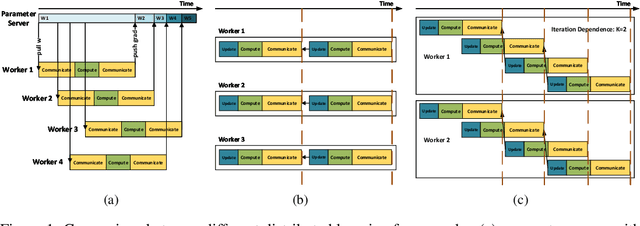


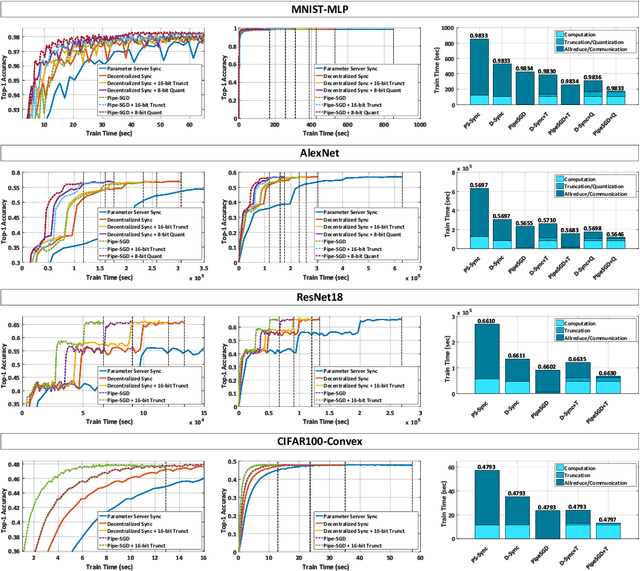
Abstract:Distributed training of deep nets is an important technique to address some of the present day computing challenges like memory consumption and computational demands. Classical distributed approaches, synchronous or asynchronous, are based on the parameter server architecture, i.e., worker nodes compute gradients which are communicated to the parameter server while updated parameters are returned. Recently, distributed training with AllReduce operations gained popularity as well. While many of those operations seem appealing, little is reported about wall-clock training time improvements. In this paper, we carefully analyze the AllReduce based setup, propose timing models which include network latency, bandwidth, cluster size and compute time, and demonstrate that a pipelined training with a width of two combines the best of both synchronous and asynchronous training. Specifically, for a setup consisting of a four-node GPU cluster we show wall-clock time training improvements of up to 5.4x compared to conventional approaches.
GradiVeQ: Vector Quantization for Bandwidth-Efficient Gradient Aggregation in Distributed CNN Training
Nov 08, 2018

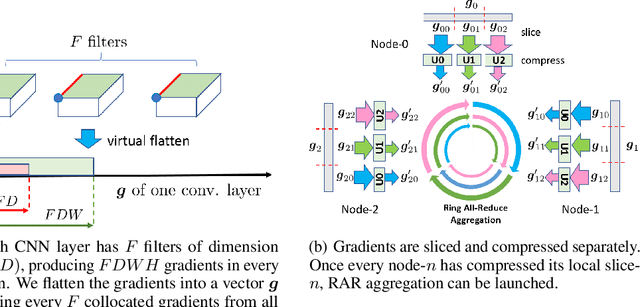
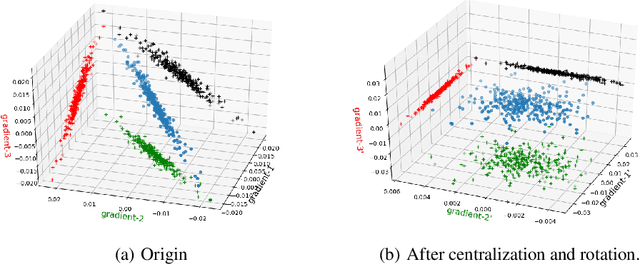
Abstract:Data parallelism can boost the training speed of convolutional neural networks (CNN), but could suffer from significant communication costs caused by gradient aggregation. To alleviate this problem, several scalar quantization techniques have been developed to compress the gradients. But these techniques could perform poorly when used together with decentralized aggregation protocols like ring all-reduce (RAR), mainly due to their inability to directly aggregate compressed gradients. In this paper, we empirically demonstrate the strong linear correlations between CNN gradients, and propose a gradient vector quantization technique, named GradiVeQ, to exploit these correlations through principal component analysis (PCA) for substantial gradient dimension reduction. GradiVeQ enables direct aggregation of compressed gradients, hence allows us to build a distributed learning system that parallelizes GradiVeQ gradient compression and RAR communications. Extensive experiments on popular CNNs demonstrate that applying GradiVeQ slashes the wall-clock gradient aggregation time of the original RAR by more than 5X without noticeable accuracy loss, and reduces the end-to-end training time by almost 50%. The results also show that GradiVeQ is compatible with scalar quantization techniques such as QSGD (Quantized SGD), and achieves a much higher speed-up gain under the same compression ratio.
GANAX: A Unified MIMD-SIMD Acceleration for Generative Adversarial Networks
May 10, 2018



Abstract:Generative Adversarial Networks (GANs) are one of the most recent deep learning models that generate synthetic data from limited genuine datasets. GANs are on the frontier as further extension of deep learning into many domains (e.g., medicine, robotics, content synthesis) requires massive sets of labeled data that is generally either unavailable or prohibitively costly to collect. Although GANs are gaining prominence in various fields, there are no accelerators for these new models. In fact, GANs leverage a new operator, called transposed convolution, that exposes unique challenges for hardware acceleration. This operator first inserts zeros within the multidimensional input, then convolves a kernel over this expanded array to add information to the embedded zeros. Even though there is a convolution stage in this operator, the inserted zeros lead to underutilization of the compute resources when a conventional convolution accelerator is employed. We propose the GANAX architecture to alleviate the sources of inefficiency associated with the acceleration of GANs using conventional convolution accelerators, making the first GAN accelerator design possible. We propose a reorganization of the output computations to allocate compute rows with similar patterns of zeros to adjacent processing engines, which also avoids inconsequential multiply-adds on the zeros. This compulsory adjacency reclaims data reuse across these neighboring processing engines, which had otherwise diminished due to the inserted zeros. The reordering breaks the full SIMD execution model, which is prominent in convolution accelerators. Therefore, we propose a unified MIMD-SIMD design for GANAX that leverages repeated patterns in the computation to create distinct microprograms that execute concurrently in SIMD mode.
 Add to Chrome
Add to Chrome Add to Firefox
Add to Firefox Add to Edge
Add to Edge